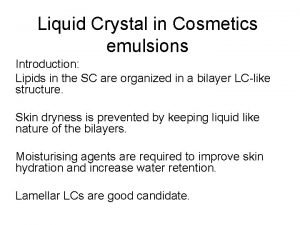Polychromatic liquid crystal laser arrays P J W

- Slides: 1

Polychromatic liquid crystal laser arrays P. J. W. Hands, S. M. Morris, S. Findeisen-Tandel, C. A. Dobson, T. D. Wilkinson, C. Gillespie, J. Schmidtke, O. Hadeler, Q. Malik, H. J. Coles Centre of Molecular Materials for Photonics and Electronics (CMMPE) http: //www-g. eng. cam. ac. uk/CMMPE/ Structure of a liquid crystal laser Chiral nematic liquid crystal – DFB resonant cavity Periodic refractive index – distributed feedback structure Photonic band-gap (reflection band) Chiral pitch length determines lasing wavelength Laser dye – Gain medium Fluorescence maximum matches lasing wavelength Absorption maximum matches optical pump wavelength Pulsed laser input – Optical pump • Focus pump laser into LC cell using lens or lenslet array (Array distributes energy, reducing optical reorientation effects) • Focussed regions of cell emit stimulated emission at long band-edge of photonic band-gap • Monochromatic laser array output (visible & infra-red) • Wavelength tuning with change in chiral pitch (Temperature, voltage, deformation, chiral dopant concentration) (Above) The photonic band gap in a chiral nematic liquid crystal. Lasing emission occurs at the long band-edge. • Laser array is recombinable into single monomode output (High power micromolecular organic lasers possible) (Right) Monochromatic LC laser array emission in the red, green and blue regions of the visible spectrum. Polychromatic LC laser arrays Images of gradient pitch LC cell showing absorption (left) and selective reflection (right). Polychromatic laser emission (red, green and blue) from a gradient pitch liquid crystal cell. • Gradient pitch cell • Simultaneous multi-wavelength laser emission • Recombinable into single white light source Funded by an EPSRC Basic Technology Research Grant, EP/D 04894 X A CAPE project, funded by CHIRALASE

